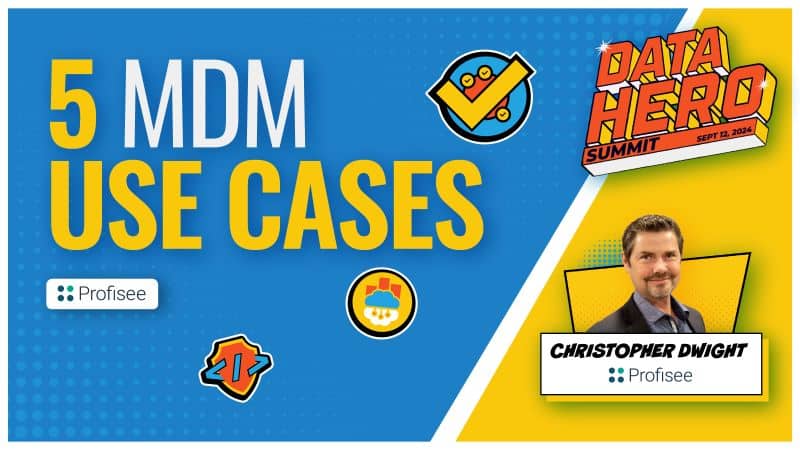It is always exciting to me when an organization decides to take the next big step in its digital transformation journey by launching a master data management (MDM) program. With that comes so much potential for not only improving your critical data quality and cleaning foundational information but also opening the door for customer, revenue, operational and production opportunities.
To truly reap the benefits of MDM, it is important to put in the necessary time, effort and research to successfully implement your MDM strategy in a way that best suits the company’s individual needs and use cases to provide value.
However, ensuring a successful deployment also means avoiding common but critical mistakes businesses make during the pre-planning stages. As a former Gartner analyst, I have seen my fair share of MDM mishaps and the various side effects within a business throughout my two and a half decades in the field.
Not only can the wrong mistake turn into a failed implementation, but it can actually cause more harm than good for an entire enterprise. Focusing on the wrong business use cases and functionalities or executing a disjointed implementation plan can hold yoaur organization back from growing the business.
Here are some of the most critical mistakes to avoid when launching your MDM initiative:
1. Assuming Everyone’s Master Data Management Implementation Plan Matches Your Own
If you want your program to be a success, you must be on the same page as everyone else involved within your organization.
Different understandings or expectations of what your MDM implementation plan will deliver only lead to internal disagreements, differing priorities and a disjointed transformation process. For your business to continue utilizing MDM, it is crucial that you are all on board and aware of the outcomes to avoid any disappointment.
Everyone has a different definition or way of looking at customers, products, employees, etc. — so never assume yours is the same as everyone else. If you are expecting the company’s MDM program to do one thing while your CDO expects another, then someone is bound to be unhappy with the result.
An MDM implementation is supposed to unify your critical data and your organization. But for that to happen, there must be a general understanding of what will be accomplished upon deployment. Remember, dissatisfied leadership means your MDM project will be cut short.
2. Poor Business Partnership
Never underestimate the power of a strong business partnership when launching your MDM initiative.
Personally, I would rather partner with an engaged and motivated senior director or VP with a budget over a CDO or CIO simply selecting MDM to “just do something”. A strong MDM partnership means a strong understanding of what it entails for both parties involved.
Unfortunately, there have been far too many times where I have seen checks signed, a CDO or CIO simply requests cleaner data or enhanced data quality and the whole project ends up going sideways.
However, if you are partnered with someone in an operational role that is motivated to help you improve your data for the specific purposes of aligning with use cases and achieving significant business outcomes, that is worth the time and money spent creating your structured MDM plan and following through with it.
3. Boiling the Ocean with Poor Scope Management
Focus on scope, scope and more scope. Much like the old expression, avoid doing too much at once by “boiling the ocean.” The initial goal is to show your CDO and MDM sponsors how the project benefits the enterprise. They expect results early on before deciding to continue with MDM for future projects.
When it comes to MDM, do not try to boil the ocean, and keep your scope limited, especially for a first launch.
Right now, you want to quickly deliver value and justify your MDM investment. For example, start with breaking two or three data silos as opposed to all of them immediately. Scope management is so important as you initiate MDM for your business. As much as you would like to “go big or go home,” that cannot happen unless you start modestly.
4. Focusing on Domains
MDM implementations are not about domains. The purpose is to create a foundation of trustworthy data to help businesses sell more products, deliver them more efficiently, create them quicker, reduce delivery fuel costs and so much more. That is what increases revenue opportunities. Attaching MDM to one or more of these specific functions is what creates room for business growth.
I cannot stress this enough, do not focus on a singular data domain. When it comes to domains, there is no room for playing favorites.
As an analyst, I saw many companies place all their eggs in the customer domain basket. This creates a false sense of security when limiting your scope. Much like data quality, leadership most likely does not care about domains.
Implementation success relies on business growth and financial results. Yes, data quality is improved, and critical data is cleaned and unified.
While that is always ideal, it is what benefits the CDOs that get your multidomain MDM project launched and funded. Focus on a business process and apply MDM accordingly. Domains will be crossed naturally throughout the implementation, but it is about the functions at the end of the day.
How Profisee Can Help
Since joining Profisee as the Head of Data Strategy, I’ve been nothing but impressed with how we prioritize the needs of each organization while respecting their time through a quicker and simpler MDM deployment process.
We offer live demos to show you firsthand how MDM can help strengthen your business and launch your strategic initiatives. If you are going to initiate a successful implementation, there must be transparency and understanding on both sides.
Profisee’s intuitive platform deploys in as little as 90 days while natively integrating with the databases, applications and services your business already uses regularly.
When approaching something as integral as critical data management, it is crucial to weigh your options and find a smarter approach that aligns with your own business goals and outcomes. Profisee is here to help with a seamless integration spanning your entire organization.
Listen to the CDO Matters Podcast
While remaining passionate about companies reaching their full strength with MDM, I want business professionals to be knowledgeable about the process and aware of the components necessary for MDM success.
For this reason, I host the CDO Matters Podcast where I sit down with thought leaders to discuss how organizations like yours can become more data-driven. To learn more, listen to our second episode where I provide more in-depth insights on key dependencies for a successful MDM program.
Malcolm Hawker
Head of Data Strategy @ Profisee
Make it easy

Malcolm Hawker
Malcolm Hawker is a former Gartner analyst and the Chief Data Officer at Profisee. Follow him on LinkedIn.












